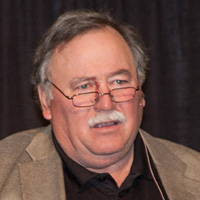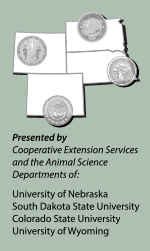Quality Beef by the Numbers
by Troy Smith, field editor, Angus Journal
RAPID CITY, S.D. (Dec. 5, 2013) — Mike Kasten says he believes in keeping cow performance records and collecting progeny carcass data. The Missouri cattleman is a vocal advocate of artificial insemination (AI) — particularly fixed-time AI. He also believes in genetic selection for superior carcass merit. Kasten told how all of these practices influence profitability when he addressed the Range Beef Cow Symposium audience Dec. 5, in Rapid City, S.D.

Mike Kasten
Sharing what he called “A Tale of Three Calves,” Kasten illustrated how much variation in value can exist among cattle of approximately the same age that look alike and are managed alike. The example was based on performance data that Kasten gathered on three calves born to cows raised in the same production environment. All calves were weaned on the same day and hauled to a feedyard on the same truck. They were fed to finish in the same pen and harvested on the same day. However, the calves represented significant differences in value and profitability.
Kasten noted differences in feedyard average daily gain, finished weight, carcass weight, yield grade and quality grade of carcasses produced by the three calves. When sold on a grid that rewards carcass merit, the heaviest carcass earning the best quality grade (Prime) represented $320 more value than the next best carcass. The value spread between the top and bottom carcasses was $813.
When all accounting was complete, including consideration of feedyard performance, the “best” calf returned a net profit of $633. The next best calf netted $206, and the third calf lost $250. The take-home message, said Kasten, is that data analysis shows where an operation makes and loses money. Just as important, he added, is that breeding and feeding high-quality cattle can be very profitable. He shared what he considers to be key steps to furthering a quality focus.
“Target genetic selection for quality,” advised Kasten, emphasizing use of expected progeny difference (EPD) values to make informed breeding decisions. “Today, through AI, we can use semen from bulls that have thousands of progeny to validate the EPDs. A DNA profile can further validate the potential of their future progeny. EPDs and DNA are tremendous risk-management tools.”
Kasten also advised commercial cow-calf producers to consider implementation of fixed-time AI. He called it a practical, cost-effective way to hasten genetic improvement. Breeding “by appointment” means producers might expect to get 55% to 65% of their cows bred to some of the best sires available in a single day. Kasten also emphasized the value of retaining AI-sired heifers as replacements.
“It’s often said that the most genetic improvement comes through the bull. I believe you can really make significant improvement through heifer selection. But you need information to make informed decisions,” stated Kasten.
“Keeping records really isn’t that scary, and time spent doing it will return more to the operation than anything else you do,” he added. “With records and the technology we have available today, I think we can select for cattle that do it all.”
Kasten spoke Thursday at RBCS XXIII. Visit the Newsroom at www.rangebeefcow.com/2013 view his PowerPoint, read his proceedings paper or listen to his presentation.
---------------------
The RBCS is a biennial educational symposium offering practical production management information. It is sponsored by the Cooperative Extension Service and animal science departments of the University of Wyoming, South Dakota State University, Colorado State University and the University of Nebraska.
Comprehensive coverage of the symposium is available online at www.rangebeefcow.com. Compiled by the Angus Journal editorial team, the site is made possible through sponsorship of LiveAuctions.tv and the cooperation of the host committee.
Editor’s Note: This article was written under contract or by staff of the Angus Journal. To request reprint permission and guidelines, contact Shauna Rose Hermel, editor, at 816-383-5270.


